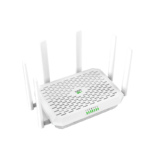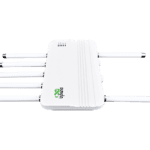
A medida que se acelera el despliegue de la tecnología 5G, consumidores y empresas se enfrentan a nuevas decisiones sobre cómo aprovechar mejor esta potente red. Entre estas decisiones está la de elegir el tipo de equipo adecuado: 5G FWA (acceso inalámbrico fijo) o 5G ODU (unidad exterior). Cada tipo ofrece ventajas distintas y se adapta a entornos y necesidades diferentes. En este blog, exploraremos las diferencias clave entre estos dispositivos 5G, examinando su diseño, rendimiento y casos de uso ideales para ayudarle a determinar cuál es el que mejor se adapta a sus requisitos específicos.
¿Qué es un CPE 5G?
Los equipos 5G en las instalaciones del cliente (CPE) son dispositivos utilizados en ubicaciones fijas que se conectan a redes 5G para proporcionar acceso a internet. Estos dispositivos están disponibles tanto en unidades interiores como exteriores y pueden conectarse de forma inalámbrica o con cables.
Diferencias entre 5G FWA y 5G ODU
5G FWA
Los dispositivos 5G FWA están diseñados para hogares u oficinas con el fin de proporcionar conectividad 5G a ordenadores, smartphones y dispositivos domésticos inteligentes.
Estos dispositivos suelen incorporar puertos Wi-Fi y LAN. Algunos incluyen soporte integrado como respaldo para estándares de red más antiguos, como 4G LTE.
El objetivo de la 5G FWA es garantizar una señal 5G fuerte y estable en el interior de los edificios, donde la señal suele degradarse debido a las paredes y otras estructuras. Las soluciones suelen pasar por el uso de antenas avanzadas y, en ocasiones, antenas externas que pueden montarse en ventanas o paredes exteriores.
ODU 5G
Las unidades exteriores 5G (ODU) suelen instalarse en tejados o muros exteriores altos para optimizar la recepción de la señal. Diseñados para durar, estos dispositivos pueden soportar condiciones ambientales adversas como lluvia, nieve y temperaturas extremas.
La principal ventaja de las ODU 5G es su capacidad para captar señales 5G con obstrucciones físicas mínimas, lo que mejora significativamente la calidad y la velocidad de la conexión en comparación con los dispositivos de interior. Sin embargo, la instalación de ODU 5G puede ser compleja y requerir asistencia profesional para montar el dispositivo de forma segura y tender los cables en interiores para la conectividad.
Consideraciones clave para la implantación de dispositivos 5G
- Intensidad de la señal
Por lo general, las ODU 5G ofrecen un mejor rendimiento en términos de intensidad y estabilidad de la señal debido a su acceso menos obstruido a las señales 5G.
- Instalación física
Los dispositivos 5G FWA suelen ser más fáciles de instalar y a menudo manejables por los propios usuarios. Estos dispositivos suelen estar diseñados para ser plug-and-play, colocados en lugares con buena recepción de señal como cerca de ventanas.
- Requisitos técnicos: No se necesitan herramientas especiales ni conocimientos profesionales, lo que permite a la mayoría de los usuarios instalar el dispositivo por sí mismos.
La instalación de ODU 5G suele ser más compleja y puede requerir equipos profesionales que trabajen en altura, como en tejados o en lo alto de paredes exteriores.
- Requisitos técnicos: Se necesitan herramientas profesionales para fijar el dispositivo, junto con medidas adicionales como la impermeabilización y el tendido de cables.
- Capacidades de los dispositivos
Ambos tipos de dispositivos deben ser compatibles con las bandas y frecuencias 5G específicas utilizadas por el proveedor de red local para garantizar un rendimiento y una compatibilidad óptimos.
- Por ejemplo, la banda C (n77) de Verizon ofrece una combinación equilibrada de rendimiento y cobertura. Extiende un alcance significativamente mayor en comparación con los espectros de banda alta, con la ventaja de una mejor penetración en edificios, lo que garantiza la accesibilidad en interiores. Además, ofrece velocidades muy superiores a las de la banda baja 5G tradicional, lo que mejora la experiencia del usuario.
- Por otro lado, la n41 de T-Mobile entra dentro del espectro de la banda 5GUC, que es crucial para alcanzar altas velocidades en dispositivos 5G Sub6. La banda n41 es fundamental para ofrecer el alto rendimiento que requieren las aplicaciones que hacen un uso intensivo del ancho de banda.
- Adaptabilidad medioambiental
Las unidades exteriores deben ser lo bastante robustas para soportar las condiciones meteorológicas locales, mientras que las interiores deben integrarse eficazmente con otras tecnologías del hogar o la oficina. Por eso, las unidades exteriores suelen tener un nivel de IP más alto que las interiores.
En cuanto al rango de temperaturas de funcionamiento, los dispositivos de interior diseñados para entornos interiores estables suelen tener un rango de temperaturas de funcionamiento de 0 °C a 40 °C, adecuado para la mayoría de los entornos residenciales y de oficina. En cambio, los dispositivos para exteriores deben poder funcionar en un rango de temperaturas más amplio, normalmente de -40 °C a 60 °C, para hacer frente a diversas condiciones meteorológicas extremas como el calor, el frío y otros elementos adversos.
En resumen, la decisión de desplegar una FWA o una ODU puede tomarse desde las siguientes perspectivas:
 |  | |
| Administrador de dispositivos | 5G FWA | ODU 5G |
| Escenario | Edificios interiores | Exteriores remotos |
| Intensidad de la señal | Señal menos fuerte | Mejor intensidad de la señal |
| Instalación | Fácil instalación, plug and play | Complejo, necesita personal y herramientas profesionales |
| Adaptabilidad al entorno | Nivel de protección IP inferior, rango de temperatura de funcionamiento más estrecho | Mayor nivel de protección IP, rango de temperatura de funcionamiento más amplio |
Conclusión
La elección entre 5G FWA y 5G ODU suele depender de las necesidades específicas del usuario, incluida la disposición física de las instalaciones, el entorno de la red 5G local y los requisitos específicos de la aplicación. Las ODU 5G son ideales para zonas donde la recepción de la señal en interiores es deficiente, mientras que los dispositivos FWA 5G son suficientes para zonas con una fuerte penetración de la señal en interiores.